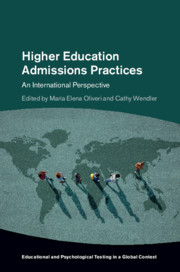Book contents
- Higher Education Admissions Practices
- Educational and Psychological Testing in a Global Context
- Higher Education Admissions Practices
- Copyright page
- Contents
- Figures
- Tables
- Contributors
- Series Editor’s Foreword
- Foreword
- Acknowledgments
- Part I Global Challenges and Common Admissions Models
- Part II Country-Specific Admissions Practices
- Part III Assessments Used in Higher Education Admissions
- Chapter 14 General Academic and Subject-Based Examinations Used in Undergraduate Higher Education Admissions
- Chapter 15 Language Proficiency Assessments in Higher Education Admissions
- Chapter 16 Measuring Student Character: Modernizing Predictors of Academic Success
- Part IV Rethinking Higher Education Admissions
- Index
- References
Chapter 14 - General Academic and Subject-Based Examinations Used in Undergraduate Higher Education Admissions
from Part III - Assessments Used in Higher Education Admissions
Published online by Cambridge University Press: 09 January 2020
- Higher Education Admissions Practices
- Educational and Psychological Testing in a Global Context
- Higher Education Admissions Practices
- Copyright page
- Contents
- Figures
- Tables
- Contributors
- Series Editor’s Foreword
- Foreword
- Acknowledgments
- Part I Global Challenges and Common Admissions Models
- Part II Country-Specific Admissions Practices
- Part III Assessments Used in Higher Education Admissions
- Chapter 14 General Academic and Subject-Based Examinations Used in Undergraduate Higher Education Admissions
- Chapter 15 Language Proficiency Assessments in Higher Education Admissions
- Chapter 16 Measuring Student Character: Modernizing Predictors of Academic Success
- Part IV Rethinking Higher Education Admissions
- Index
- References
Summary
This chapter describes academic assessments that measure general or subject-specific skills that are used around the world. Two types of assessments are discussed: exit exams used when leaving an institution and entrance exams required for admittance to an institution. General characteristics of the tests, concerns, and psychometric challenges for their use are summarized. Detailed examples ofassessments used in specific countries are given.
- Type
- Chapter
- Information
- Higher Education Admissions PracticesAn International Perspective, pp. 237 - 255Publisher: Cambridge University PressPrint publication year: 2020
References
- 2
- Cited by



